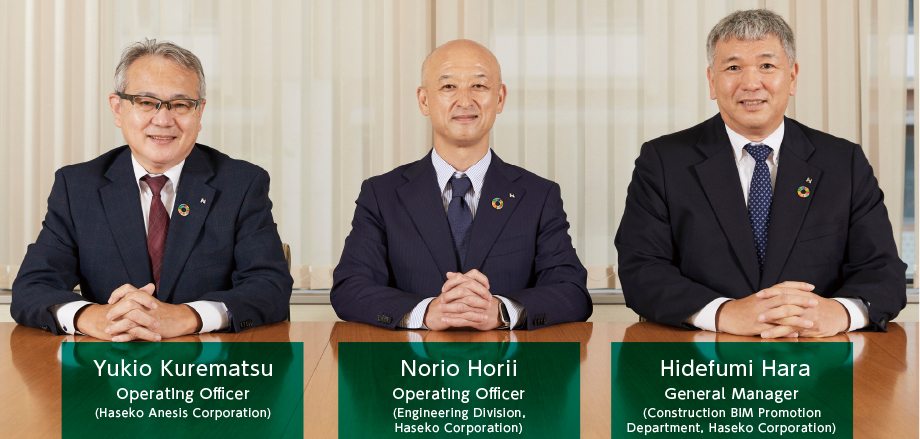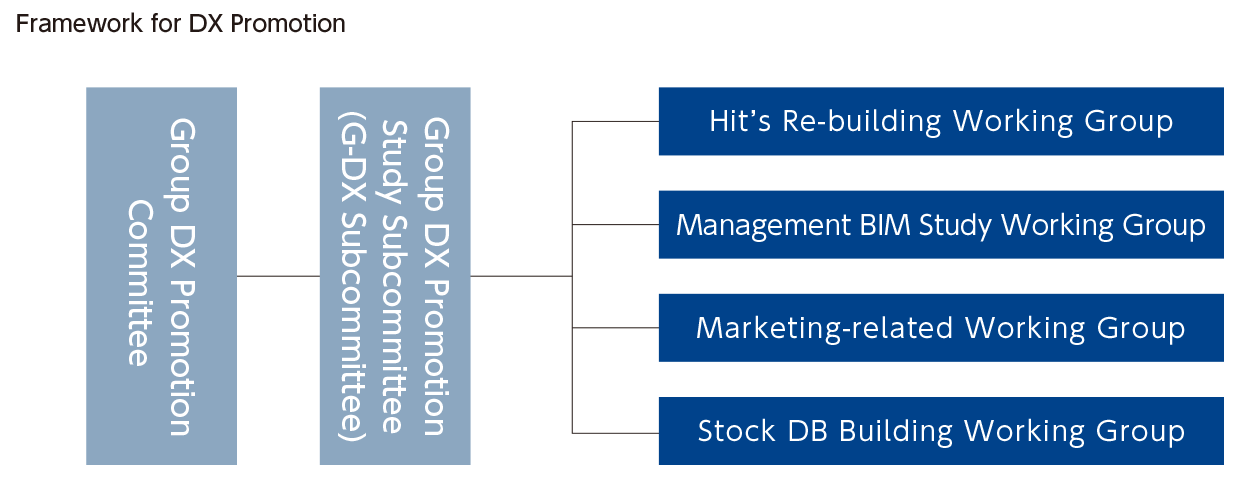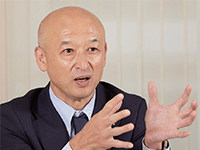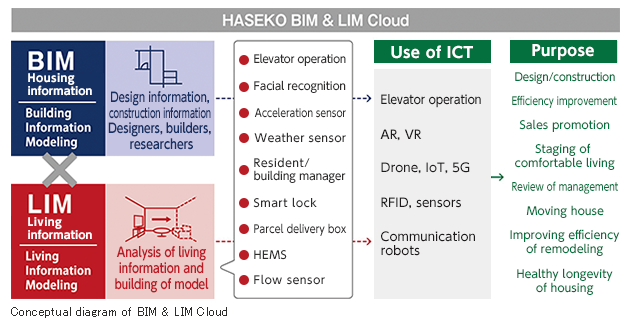DX for “Enriched Lives” as Imagined and
Evolved by the Haseko GroupFiscal 2022 Special Feature
Three key persons who lead the Group DX Promotion Study Subcommittee (hereinafter G-DX Subcommittee), which was established to promote DX in the Haseko Group, gathered to discuss where Haseko’s DX currently stands as it moves forward to promote the use and development of DX in all situations, from design and construction to management, repair, and lifestyle, with the intention of further enriching people’s lives in Japan.

- PROFILE
-
Yukio Kurematsu Operating Officer(Haseko Anesis Corporation)
Kurematsu studied construction engineering in the United States after joining the Company and moved into corporate planning on his return to Japan. He is responsible for the Service-related Business as a General Manager of the Haseko Anesis Corporation. He has been involved in the Value Creation Division since its establishment as the head of the division’s operations. Vice Chair of the DX Promotion Committee launched in 2021. Chair of the G-DX Subcommittee.
<Conviction toward DX>I believe that the kind of mindset reform that would transform the situation on the ground in an instant, without being constrained by past ways of working or thinking, will be particularly important for the promotion of DX.
Norio Horii Operating Officer(Engineering Division, Haseko Corporation)
Having gained experience on construction sites for three years after joining the Company, Horii worked in design in the Engineering Division. From 2012, in addition to his design duties, he was involved in building the “Haseko-version BIM” as the person responsible for the introduction of BIM. Member of the G-DX Subcommittee.
<Conviction toward DX>BIM is an enormous cluster of digital information. I hope that we can take advantage of digital technologies to rebuild the business model of the entire Haseko Group, with BIM resources at its core.
Hidefumi Hara General Manager(Construction BIM Promotion Department, Haseko Corporation)
Hara has been working at the frontline of construction sites since joining the Company. He took the initiative in introducing CAD at a time when design work on site was predominantly done by hand. When the Construction BIM Promotion Department was established, demand for his hands-on experience led to his transfer to the new department. Member of the G-DX Subcommittee.
<Conviction toward DX>It is precisely because of the Haseko Group’s ability to share information smoothly from design and construction through to management that we will be able to build DX that is brimming with originality.

Integrated process from design through to construction is Haseko’s style
What are the distinctive features of the Haseko-version BIM?

Horii Today, BIM is in wide use among the major general contractors and design firms. However, it is commonly separated into design BIM and construction BIM, and there are many cases in which data cannot be used efficiently in an integrated manner.
Fundamentally, the ideal BIM would enable data to be connected seamlessly from design through to construction, sales and onto maintenance and management. However, the elements required for BIM by the design side and those required by the construction side differ, making it difficult for design and construction to share a single set of BIM data. For the design side, design images such as color and form are important, so they want to be able to convert them to 3D to verify and present them in a way that is easy to understand. For the construction side, on the other hand, finely detailed composition and numerical data such as quantity and size are important. These data cannot be used at the production site unless their degree of precision is increased to the point where they can be used as is. There are people who are happy with a rough shape and people who are unsatisfied without a finely detailed BIM, and it is difficult for these two sides to share data. This results in situations where a BIM created by the design team would be almost completely unusable by the construction side.
However, more than 90% of the work at Haseko Corporation is done in an integrated manner between design and construction. In addition, many of our businesses are specialized in condominiums, which makes it easy to set rules and recycle data. This is indeed the most distinctive feature of the Haseko-version BIM, and in this sense, I think that our Company is an organization that is particularly suited to BIM.
Precisely because design and construction account for more than 90% of our work, we are able to build BIM that can be used jointly with the construction team from the design stage. This shared use of BIM places a burden on the design side in the initial stages, but it means greater efficiency overall from construction to sales. We call this “front loading,” and our ability to do this is the Company’s greatest strength.
We have also been working closely with our partner companies (148 companies in the Tokyo metropolitan area and 143 companies in the Kansai and Tokai areas; as of March 2022). This means that their voices are reflected from the design stages, creating the groundwork for even smoother progress.
Hara This, precisely, is the strength of our “quaternity” (four entities in one body) that has no equal among our competitors. Our design, construction, and technology promotion divisions, along with our partner companies, form a “quaternity” that has continued to share information and cooperate in other ways for over a quarter of a century. This is an advantage even in the era of BIM. For example, the site supervisors listen to the opinions of the tradespeople and convey that feedback upstream, where improvements are made to standardize and normalize optimal operational systems downstream and make them more efficient, and this is incorporated into the BIM. The Company has always had the foundations for making that happen.
Changing the mindset of all 8,000 employees to
pursue DX reform
100% introduction of BIM has now been achieved, and Phase 2 has finally begun. What is the G-DX Subcommittee’s role in that phase?
Kurematsu Regarding the more labor-intensive service-related businesses, such as management and repair, there is no team for supporting DX even among the Group companies. It was for this reason that the Group DX Promotion Committee was established with the function of promoting DX across the entire Haseko Group by linking the various service-related companies horizontally. The objective of its activities is to create a back-up framework that will enable the individual Group companies to engage in DX at their respective sites. Trials cost money, so we have established R&D funding in the form of a new DX budget. We have built a mechanism in which DX can be trialed on the ground and, if the trial goes well, the individual companies can then pursue it further with their own budgets.
Horii A reporting meeting of associated companies is held every six months, at which various priority issues are raised by the individual Group companies. They present detailed materials, such as what kind of measures they developed or concrete actions they took this period and what they were planning to implement in the following period. The Group DX Promotion Committee deliberates on these reports and makes suggestions for areas where DX could be put to use. For each theme that emerges from this process, a working group is formed to work specifically on that theme.
Hara The construction division has communicated its desire to work together to achieve reform. When providing a certain digital tool to a site, simply converting its conventional operations to digital does not offer major benefits from DX. Since changing to a method in which the sites themselves work out what areas of their operations they would reform and we provide the digital tools needed for that reform, we have started to see the benefits. This has made me painfully aware that, without an accompanying reform in mindset, such as making a 180° change to the operations themselves, we will not see results.
Kurematsu For example, just photographing something that is handwritten will not improve efficiency in itself. It requires a mindset of also eliminating the entire series of processes itself, including printing and filing, all in one go, to render them all unnecessary. Storing what is needed on the cloud will eliminate the effort of filing, and searching will become exponentially easier.
Hara Currently, we are engaging in the DX theme of information sharing and in the improvement of efficiency, namely the thorough elimination of time spent searching, time spent moving from one place to another, and time spent waiting, as our priorities. The digitalization environment is now ready, so I see Phase 2 as the phase in which we will change the mindsets of each and every employee who uses it.
Horii To change employees’ mindsets, in FY2021, we held a “DX Academy,” which was made available to all 8,000 employees. We invited Toyo University Professor, Ken Sakamura, who created TRON, an operating system architecture in use worldwide, to deliver e-learning modules on basic topics such as “What is DX?” and “Challenges for the Realization of DX,” in an attempt to change the way our employees’ awareness. After that, we conducted an “Innovation Leader Development Program” for certain employees selected as DX leaders, and we are working on the further promotion of DX.
Beyond the overlaying of BIM and LIM, a vision of future living appears
Following on from BIM, efforts are now being placed into LIM (Living Information Modeling). How did this original concept of LIM come about?

Kurematsu The Company has always believed that our job did not end with the completion of our condominiums, and we place importance in providing appropriate after-sales care, including post-construction management. Information about problems at the condominiums we have built is collated by a section called the CS Promotion Department, and, where necessary, the whole company is involved in resolving those problems. The information is then fed back to design and construction to be put to use next time.
However, this methodology takes time and effort. In some situations, it can also lead to complaints being made by the customer. The concept of LIM emerged from the idea of installing a variety of sensors in a building to make it easier to understand the status of faults and building systems for taking photographs for remote verification, which would improve after-sales service responses and building maintenance and management by leaps and bounds. Depending on the systems installed, excellent condominium after-sales service responses could be achieved. This is how we are differentiating ourselves from our competitors.
Centralizing and visualizing all living information, including regular building inspection data and elevator and other operational data, is the concept of LIM. We also came up with the idea of overlaying LIM and BIM data to create a platform for buildings’ management, and we are now working on the construction of the “HASEKO BIM & LIM Cloud”. We have installed sensor devices, including seismic sensors and environmental sensors in Haseko Group-owned rental condominium buildings, as well as facial recognition systems, and are currently conducting demonstration trials of the use of data.
In addition, condominiums generally undergo large-scale repairs every twelve years. Storing the records of those repairs on BIM will make the condition of the building before and after the repairs apparent. The repairs made a further twelve years later will also be stored as repair history on the BIM. This will make it easy to see the building’s history on the BIM, which will assist with asset maintenance and appraisal. We also believe that this information will be beneficial for residents.
Hara We are also considering sensors for measuring the temperature of building walls, because we believe that this data could be put to use in large-scale repairs. For example, if we can see that the south face of the building is hotter, meaning severe deterioration, we could employ highly durable, more expensive materials on that side. However, if there is less deterioration on the north face, it may not be necessary to use such durable materials. In some cases, the same kind of results may be obtained in day-to-day maintenance, not in large-scale repairs. Organization of deterioration over time as digital data could assist with preventive maintenance, enabling us to provide buildings that have longer useful lives.
Horii This will also benefit the customers. In large-scale repairs, we can show clear, visible evidence that certain repairs are not needed, giving specific reasons, which will lead to more economical repairs.
I would like to provide customers with “fault prediction.” By combining BIM and LIM, we will be able to detect situations that are likely to cause problems in advance. If our call center could communicate to the customer, at a point when the problem has not yet occurred, that a problem is likely to occur soon and so we will deal with it before it does, customer satisfaction is sure to increase, and business opportunities will likely emerge.
Hara I believe that, once we have collected a mass of LIM data, various new business opportunities of this nature will arise. For example, diversity is increasing among residents, with people of different ethnicities and languages living in the same condominium buildings. When we consider condominium management and operations in such times, conventional methods probably have their limits. By centralizing information with BIM & LIM, we can see the condition of the building in 3D. This is easy to understand regardless of language, which will make it easier to obtain understanding for repairs and the like.

DX, going beyond “things” to nurture “experiences” and “time”
Could you describe your future vision for DX in the Haseko Group going forward?

Hara Within the Company’s Corporate Philosophy of “To contribute to society by creating an optimal environment for cities and people,” we are already providing “things” in the daily living environment. Going forward, in addition to conventional building maintenance and management, if we can collect the daily living information of customers who live in those buildings, we can create services that offer “experiences” and “time.”
Kurematsu To give an example, we could install seismic sensors in student condominiums and, if an earthquake occurs, we could provide services such as informing the students’ parents living in regional areas about the seismic intensity of the quake and the state of damage.
Hara In future, we might even be able to indicate the best route for residents from their condominiums to the closest evacuation site when a disaster strikes. If we could provide instructions such as telling people living on a certain floor to take a certain staircase, we could improve congestion on emergency staircases. As we continue to proceed with mindset reform and make more and more progress with DX, we hope you will watch over us with a sense of excitement about what kind of condominiums Haseko will come up with next and what kinds of condominium management services we will develop and offer.
Kurematsu The HASEKO BIM & LIM Cloud has already started operating, so our next challenge will be how to grow it into a valuable platform. Total digitalization, starting with sales and marketing to customers, right through to handling after-sales complaints, is a task that we are currently working on in coordination with the various Group companies. Through DX, we hope to realize the kind of support that will allow customers to live rich, comfortable lives for a long time in the housing that we have built or that we manage.
- Sustainability TOP
- Message from the Management
- Message from the Officer in Charge of Sustainability Promotion
- Haseko Group's Sustainability Management
- Climate Change Response
- The Digital Transformation Strategy of the Haseko Group
- D&I at the Haseko Group
- Creating attractive living spaces
- Building a company worth working at
- Protecting the precious environment
- Nurturing a culture of trust
- ESG Data and Disclosures
- External Evaluations and Awards
- Integrated Report
- Philosophy and Policies
- Special feature archives
